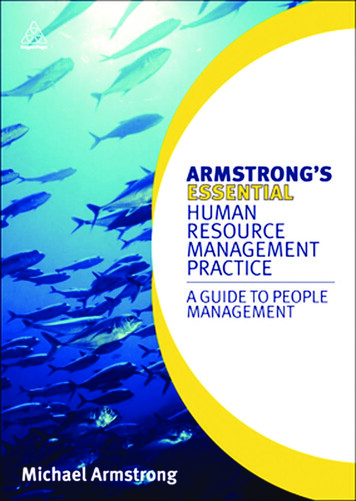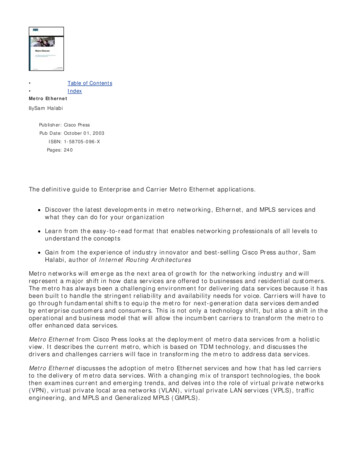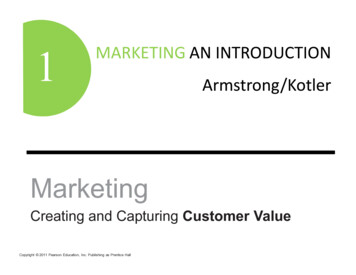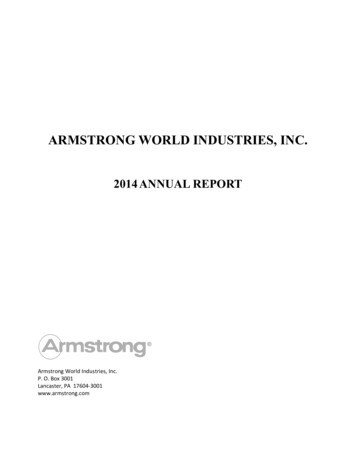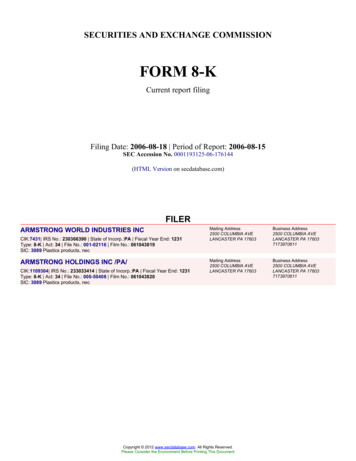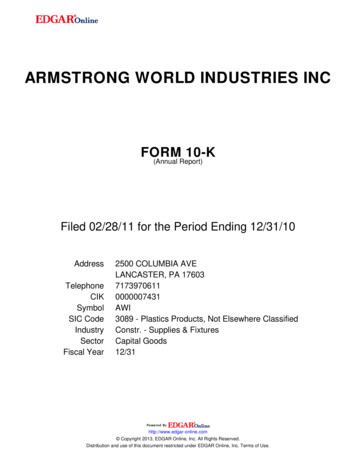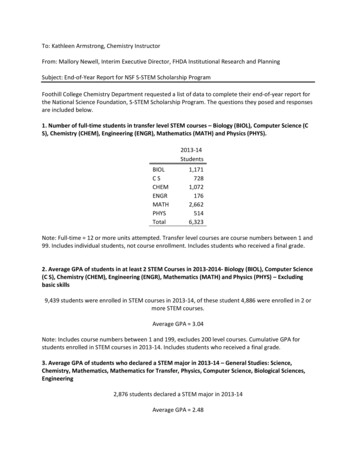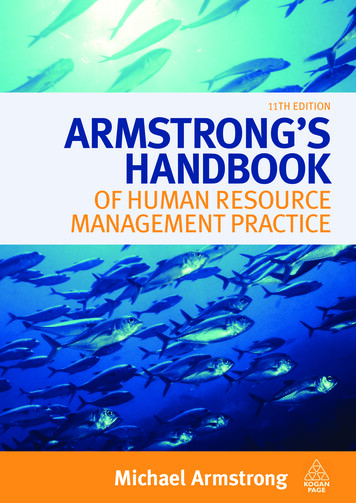
Transcription
11TH EDITIONARMSTRONG’SHANDBOOKOF HUMAN RESOURCEMANAGEMENT PRACTICEMichael Armstrong
iARMSTRONG’SHANDBOOKOF HUMAN RESOURCEMANAGEMENT PRACTICE
ii
iiiARMSTRONG’SHANDBOOKOF HUMAN RESOURCEMANAGEMENT PRACTICE11TH EDITIONMichael ArmstrongLondon and Philadelphia
ivPublisher’s noteEvery possible effort has been made to ensure that the information contained in this book is accurate at thetime of going to press, and the publisher and authors cannot accept responsibility for any errors or omissions,however caused. No responsibility for loss or damage occasioned to any person acting, or refraining fromaction, as a result of the material in this publication can be accepted by the editor, the publisher or any of theauthors.First edition published in 1977 as A Handbook of Personnel Management Practice by Kogan Page LimitedSeventh edition published in 1999 as A Handbook of Human Resource Management PracticeEleventh edition published in 2009 as Armstrong’s Handbook of Human Resource Management PracticeApart from any fair dealing for the purposes of research or private study, or criticism or review, as permittedunder the Copyright, Designs and Patents Act 1988, this publication may only be reproduced, stored or transmitted, in any form or by any means, with the prior permission in writing of the publishers, or in the case ofreprographic reproduction in accordance with the terms and licences issued by the CLA. Enquiries concerningreproduction outside these terms should be sent to the publishers at the undermentioned addresses:120 Pentonville RoadLondon N1 9JNUnited Kingdomwww.koganpage.com525 South 4th Street, #241Philadelphia PA 19147USA Michael Armstrong, 1977, 1984, 1988, 1991, 1995, 1996, 1999, 2001, 2003, 2006, 2009The right of Michael Armstrong to be identified as the author of this work has been asserted by him in accordance with the Copyright, Designs and Patents Act 1988.ISBN 978 0 7494 5242 1British Library Cataloguing-in-Publication DataA CIP record for this book is available from the British Library.Library of Congress Cataloging-in-Publication DataArmstrong, Michael, 1928–Armstrong’s handbook of human resource management practice / Michael Armstrong. -- Eleventh ed.p. cm.Rev. ed. of: A handbook of human resource management practice. 10th ed. 2006.Includes bibliographical references and index.ISBN 978-0-7494-5242-11. Personnel management --Handbooks, manuals, etc. I. Armstrong, Michael, 1928– Handbook of humanresource management practice. II. Title. III. Title: Handbook of human resource management practice.HF5549.17.A76 2009658.3--dc222008053904Typeset by Saxon Graphics Ltd, DerbyPrinted and bound in India by Replika Press Pvt Ltd
vContents in BriefPrefacexxvPart I1.2.3.4.5.6.7.8.9.10.Human Resource ManagementThe Practice of Human Resource ManagementStrategic Human Resource ManagementHR StrategiesHuman Capital ManagementThe Role and Organization of the HR FunctionThe Role of the HR PractitionerThe Impact of HRM on PerformanceInternational HRMCorporate Social ResponsibilityHuman Resource Management Research Methods1325476581104135150165174Part II11.12.13.Human Resource Management ProcessesCompetency-based HRMKnowledge ManagementHigh-performance Work Systems199201218230Part III14.15.16.Work and EmploymentWorkThe Employment RelationshipThe Psychological Contract249251260276Part IV17.18.Organizational BehaviourThe Essence of Organizational BehaviourCharacteristics of People289291299
viBrief Contents19.20.21.22.MotivationEngagement and CommitmentHow Organizations FunctionOrganizational Culture316335357383Part V23.24.25.26.27.Organization Design and DevelopmentOrganization DesignOrganization DevelopmentChange ManagementJob, Role, Competency and Skills AnalysisJob and Role Design and Development401403415423443466Part VI28.29.30.31.32.33.34.35.36.37.People ResourcingPeople Resourcing StrategyHuman Resource PlanningPeople Resourcing PracticeRecruitment and SelectionSelection InterviewingSelection TestsTalent ManagementCareer ManagementIntroduction to the OrganizationRelease from the Organization477479485495514540567579590602609Part VII Performance Management38.The Process of Performance Management39.360-degree Feedback615617643Part g and DevelopmentLearning and Development StrategyThe Process of Learning and DevelopmentLearning and Development Programmes and EventsHow People LearnOrganizational LearningManagement Development
Brief ContentsPart IX46.47.48.49.50.51.52.53.Rewarding PeopleReward ManagementJob EvaluationMarket Rate AnalysisGrade and Pay StructuresContingent PayRewarding Special GroupsEmployee Benefits, Pensions and AllowancesManaging Reward Systems733735755783795815839849859Part X54.55.56.57.Employee RelationsThe Employee Relations FrameworkEmployee Relations ProcessesEmployee VoiceEmployee Communications875877905935949Part XI58.59.Health, Safety and Employee Well-beingHealth and SafetyEmployee Well-being957959975Part XII60.61.62.HR Policies, Procedures and SystemsHR PoliciesHR ProceduresHR Information Systems98598710001010AppendicesA.Example of Employee Engagement and Commitment SurveyB.Example of Performance Management SurveyC.Example of Reward SurveyD.Learning and Development Activities and Methods10171019102010211022Useful Website AddressesSubject IndexAuthor Index103110341057vii
viiiThis page has been left intentionally blank
ixContentsSupporting resources for instructors and studentsList of figuresList of tablesPrefacePart I1.2.3.4.Human Resource ManagementThe Practice of Human Resource ManagementIntroduction 4; Human resource management defined 4; Theobjectives of HRM 5; Theories of HRM 6; Characteristics of HRM 7;The development of the concept of HRM 13; Reservations aboutHRM 14; The context of HRM 17; The ethical dimension 19Strategic Human Resource ManagementIntroduction 26; The conceptual basis of strategic HRM 26;Strategic HRM defined 29; The resource-based view of strategicHRM 30; Strategic fit 32; Perspectives on strategic HRM 32; Thebest practice approach 33; The best fit approach 35; Bundling 37;The reality of strategic HRM 39; Practical implications ofstrategic HRM theory 40HR StrategiesIntroduction 48; What are HR strategies? 48; General HRstrategies 49; Specific HR strategies 52; Criteria for an effective HRstrategy 53; How should HR strategies be formulated? 54; Issues indeveloping HR strategies 55; Implementing HR strategies 59Human Capital ManagementIntroduction 66; Human capital management defined 66; Theconcept of human capital 66; The constituents of human capital 68;Human capital measurement 69; Human capital internalreporting 75; Human capital external reporting 76; IntroducingHCM 77xixxxixxiiixxv13254865
xFull Contents5.6.7.8.9.10.Part II11.The Role and Organization of the HR FunctionIntroduction 82; The role of the HR function 82; The organizationof the HR function 84; Evaluating the HR function 87; HR sharedservice centres 92; Outsourcing HR work 93; Offshoring 94;Using management consultants 94; Marketing the HR function 95;HR budgeting 96; The HR role of front line managers 97The Role of the HR PractitionerIntroduction 105; The basic role 105; The business partner role 106;The strategic role of HR specialists 108; The change agent role 111;The internal consultancy role 112; The service delivery role 112; Theguardian of values role 113; Models of HR roles 113; Gaining supportand commitment 117; Ethical considerations 120; Professionalism inhuman resource management 121; Ambiguities in the role of HRpractitioners 122; Conflict in the HR contribution 124; The qualitiesrequired by HR professionals 125; Continuous professionaldevelopment 129The Impact of HRM on PerformanceIntroduction 136; The impact made by HRM 136; How HRMstrategies make an impact 141; How HRM practices make animpact 144International HRMIntroduction 151; International HRM defined 151; Issues ininternational HRM 151; Global HR policies and practices 156;Managing expatriates 156Corporate Social ResponsibilityIntroduction 166; Strategic CSR defined 166; CSR activities 167; Therationale for CSR 168; Developing a CSR strategy 170Human Resource Management Research MethodsIntroduction 175; The nature of research 175; Researchphilosophy 176; Planning and conducting research programmes 178;Literature reviews 180; Quantitative and qualitative methods ofresearch 181; Methods of collecting data 182; Processes involved inresearch 187; Statistical analysis 191Human Resource Management ProcessesCompetency-based HRMIntroduction 202; Types of competencies 202; Competencyframeworks 204; Coverage of competencies 209; Applications ofcompetency-based HRM 210; Developing a competencyframework 212; Competencies and emotional intelligence 21481104135150165174199201
Full Contents12.13.Part III14.15.16.Part IV17.Knowledge Management218Introduction 219; Knowledge management defined 219; The conceptof knowledge 220; The purpose and significance of knowledgemanagement 221; Knowledge management strategies 222; Knowledgemanagement systems 223; Knowledge management issues 223; Thecontribution of HR to knowledge management 225High-performance Work Systems230Introduction 231; High-performance culture 231; High-performancework system defined 232; Characteristics of a high-performancework system 234; Components of an HPWS 235; Impact of highperformance work systems 238; Reservations about the impact ofan HPWS 240; Developing a high-performance work system 241Work and EmploymentWorkIntroduction 252; The nature of work 252; Organizational factorsaffecting work 255; Changes in the pattern of employment 256; Thefuture of work 257The Employment RelationshipIntroduction 261; The employment relationship defined 261; Thebasis of the employment relationship 262; Employment relationshipcontracts 263; What is happening to the employment relationship 265;Managing the employment relationship 266; Developing a hightrust organization 267; Theories explaining the employmentrelationship 270The Psychological ContractIntroduction 277; The psychological contract defined 277; Thepsychological contract and the employment relationship 279; Thesignificance of the psychological contract 280; Changes to thepsychological contract 282; State of the psychological contract2004 283; How psychological contracts develop 284; Developing andmaintaining a positive psychological contract 285249251260276Organizational Behaviour289The Essence of Organizational Behaviour291Introduction 292; Organizational behaviour defined 292;Characteristics of organizational behaviour 292; Organizationalbehaviour and the social and behavioural sciences 293; Explainingorganizational behaviour 294; Factors affecting organizationalbehaviour 294; The sources and applications of organization behaviourtheory 295; The significance of organizational behaviour theory 296xi
xiiFull Contents18.19.20.21.22.Part V23.24.25.Characteristics of PeopleIntroduction 300; Individual differences 300; Personalcharacteristics 302; Types of behaviour 307; Implications for HRspecialists 311MotivationIntroduction 317; Motivation defined 317; Types of motivation 318;Motivation theories 319; Motivation and money 329; Motivationstrategies 330Engagement and CommitmentIntroduction 336; The concepts of engagement and commitmentcompared 336; Employee engagement 337; Organizationalcommitment 345; The contribution of HR to developingcommitment 351How Organizations FunctionIntroduction 358; Organization theory 359; Organizationstructure 365; Types of organization 366; Organizationalprocesses 369Organizational CultureIntroduction 384; Organizational culture defined 384; Organizationalclimate defined 385; How organizational culture develops 386; Thediversity of culture 387; The components of culture 387; Classifyingorganizational culture 390; Assessing organizational culture 391;Measuring organizational climate 392; Appropriate cultures 394;Supporting and changing cultures 394Organization Design and DevelopmentOrganization DesignIntroduction 404; The process of organizing 404; Aims oforganization design 405; Conducting organization reviews 406;Who does the work? 412Organization DevelopmentIntroduction 416; Organization development defined 416;Organization development programmes 417; Assumptions andvalues of organization development 417; Organization developmentactivities 418Change ManagementIntroduction 424; Types of change 424; The change process 426;Change models 426; Resistance to change 430; Implementingchange 432; Guidelines for change management 433; Organizationaltransformation 434; The role of HR in managing change 437299316335357383401403415423
Full Contents26.27.Part VI28.29.30.31.32.33.Job, Role, Competency and Skills AnalysisIntroduction 444; Definitions 444; Job analysis 446; Jobdescriptions 449; Role analysis and role profiles 451; Generic roleprofiles 453; Behavioural competency modelling 454; Analysingtechnical competencies 461; Skills analysis 461Job and Role Design and DevelopmentIntroduction 467; Job design 467; Role development 473443People ResourcingPeople Resourcing StrategyIntroduction 480; The objective of people resourcing strategy 480; Thestrategic HRM approach to resourcing 480; Integrating business andresourcing strategies 481; The components of people resourcingstrategy 482; Bundling resourcing strategies and activities 482Human Resource PlanningIntroduction 486; Human resource planning defined 486; Aims ofhuman resource planning 487; Use of human resource planning 488;Approaches to human resource planning 488People Resourcing PracticeIntroduction 496; Employee value proposition 496; Employerbrand 497; Employee turnover 497; Retention planning 503; Absencemanagement 506; Flexibility planning 509Recruitment and SelectionIntroduction 515; The recruitment and selection process 515;Defining requirements 515; Recruitment planning 518; Attractingcandidates 519; Processing applications 527; Selection methods 529;Dealing with recru
He has sold over 500,000 books on the subject of HRM (published with Kogan Page). Kogan Page 120 Pentonville Road London N1 9JN United Kingdom www.koganpage.com Kogan Page US 525 South 4th Street, #241 Philadelphia PA 19147 USA 9 780749 452421 ISBN: 978-0-7494-5242-1 Human resource management Michael Armstrong ARMSTRONG’S HANDBOOK ARMSTRONG’S HANDBOOK OF HUMAN RESOURCE MANAGEMENT
